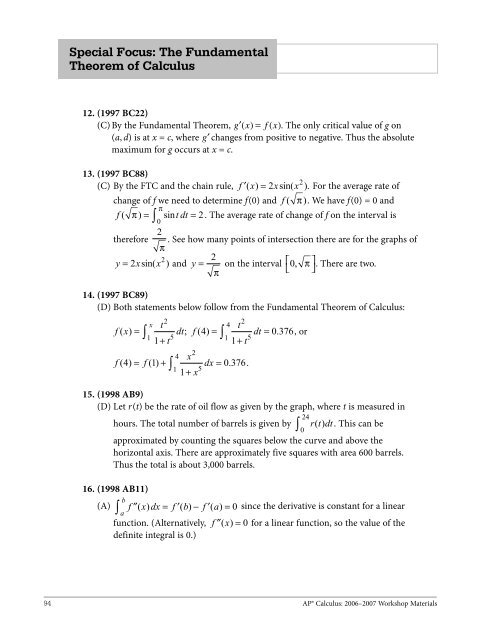AP Calculus
Calculus_SF_Theorem
Calculus_SF_Theorem
You also want an ePaper? Increase the reach of your titles
YUMPU automatically turns print PDFs into web optimized ePapers that Google loves.
Special Focus: The Fundamental<br />
Theorem of <strong>Calculus</strong><br />
12. (1997 BC22)<br />
(C) By the Fundamental Theorem, g′ ( x) = f ( x). The only critical value of g on<br />
(a, d) is at x = c, where g′<br />
changes from positive to negative. Thus the absolute<br />
maximum for g occurs at x = c.<br />
13. (1997 BC88)<br />
2<br />
(C) By the FTC and the chain rule, f ′( x) = 2xsin( x ). For the average rate of<br />
change of f we need to determine f(0) and f ( π ). We have f(0) = 0 and<br />
π<br />
∫ 0<br />
f ( π ) = sin t dt = 2 . The average rate of change of f on the interval is<br />
2<br />
therefore . See how many points of intersection there are for the graphs of<br />
π<br />
2<br />
y = 2xsin( x ) and y = 2 on the interval ⎡0, π ⎤. There are two.<br />
π<br />
⎣ ⎦<br />
14. (1997 BC89)<br />
(D) Both statements below follow from the Fundamental Theorem of <strong>Calculus</strong>:<br />
x<br />
2<br />
t<br />
4<br />
2<br />
t<br />
f ( x) = ∫ dt; f ( 4) = ∫ dt = 0.<br />
376, or<br />
1 5<br />
5<br />
1+<br />
t<br />
1<br />
1+<br />
t<br />
f ( 4) x<br />
f ( 1) 4<br />
2<br />
= + ∫<br />
1 x dx = 0 . 376.<br />
1 5<br />
+<br />
15. (1998 AB9)<br />
(D) Let r(t) be the rate of oil flow as given by the graph, where t is measured in<br />
hours. The total number of barrels is given by<br />
∫<br />
24<br />
0<br />
r( t)<br />
dt<br />
. This can be<br />
approximated by counting the squares below the curve and above the<br />
horizontal axis. There are approximately five squares with area 600 barrels.<br />
Thus the total is about 3,000 barrels.<br />
16. (1998 AB11)<br />
b<br />
(A)<br />
∫ f ′′( x) dx = f ′( b) − f ′( a) = 0 since the derivative is constant for a linear<br />
a<br />
function. (Alternatively, f ′′( x) = 0 for a linear function, so the value of the<br />
definite integral is 0.)<br />
94<br />
<strong>AP</strong>® <strong>Calculus</strong>: 2006–2007 Workshop Materials


